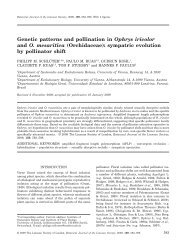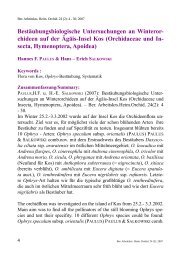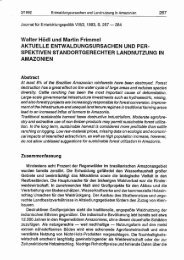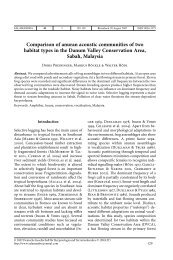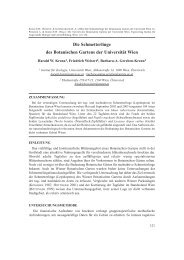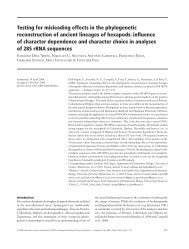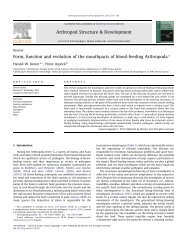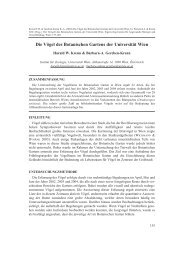Circulatory organs of Diplura "Hexapoda#] the basic design in ...
Circulatory organs of Diplura "Hexapoda#] the basic design in ...
Circulatory organs of Diplura "Hexapoda#] the basic design in ...
- No tags were found...
You also want an ePaper? Increase the reach of your titles
YUMPU automatically turns print PDFs into web optimized ePapers that Google loves.
PERGAMONInternational Journal <strong>of</strong> Insect Morphology 17 "0888# 60Ð68<strong>Circulatory</strong> <strong>organs</strong> <strong>of</strong> <strong>Diplura</strong> "<strong>Hexapoda#</strong>] <strong>the</strong> <strong>basic</strong> <strong>design</strong> <strong>in</strong>Hexapoda
61B[!A[ Gereben!Krenn\ G[ Pass : International Journal <strong>of</strong> Insect Morpholo`y 17 "0888# 60Ð681[1[ Light microscopyThe specimens were _xed <strong>in</strong> Dubosq!Brasil mixtureand stored <strong>in</strong> 69) ethanol[ The isolated body parts weredehydrated with ethanol[ Us<strong>in</strong>g ei<strong>the</strong>r acetone or pro!pylene oxide as an <strong>in</strong>termedium\ <strong>the</strong>y were embedded <strong>in</strong>ERL!3195 epoxy res<strong>in</strong> "Spurr medium# under vacuumimpregnation[ Serial semi!th<strong>in</strong> sections "0 mm# were madeon an ultramicrotome with glass knives or a diamondknife "Diatome# and sta<strong>in</strong>ed <strong>in</strong> a mixture <strong>of</strong> 0) azure IIand 0) methylene blue <strong>in</strong> an aqueous 0) borax solutionfor approximately 29 s at 79>C[1[2[ Transmission electron microscopy "TEM#Specimens <strong>of</strong> Campodea au`ens were dissected and_xed <strong>in</strong> a 1) paraformaldehyde:1[4) glutaraldehydemixture and\ subsequently\ <strong>in</strong> 0) osmium tetroxide[Both _xatives were bu}ered <strong>in</strong> 9[0 M sodium cacodylate"pH 6[3#[ Dehydration and embedd<strong>in</strong>g were performedas described for semi!th<strong>in</strong> sections[ Ultrath<strong>in</strong> sectionswere sta<strong>in</strong>ed <strong>in</strong> uranyl acetate "0 h\ 39>C# and lead citrate"79 s\ 19>C# <strong>in</strong> a LKB 1058 Ultrasta<strong>in</strong>er and exam<strong>in</strong>edwith a Zeiss EM 891 microscope[1[3[ In vivo observationsThe <strong>in</strong>dividuals were anaes<strong>the</strong>tized by carbon dioxidegas and _xed onto a glass plate with adhesive tape[ Hemo!lymph ~ow was exam<strong>in</strong>ed by observ<strong>in</strong>g <strong>the</strong> hemocytemovement with a stereomicroscope us<strong>in</strong>g heat!protect<strong>in</strong>g_lters[2[ Results2[0[ Dorsal vessel tube\ ostia and <strong>in</strong>tracardiac valves2[0[0[ Campodea augensThe dorsal vessel is a straight tube extend<strong>in</strong>g from <strong>the</strong>head to <strong>the</strong> 09th abdom<strong>in</strong>al segment where it opens <strong>in</strong>toan enlarged hemolymph space\ which we call <strong>the</strong> caudalchamber "Fig[ 0#[Along <strong>the</strong> dorsal vessel|s course through <strong>the</strong> body\ itsdistance to <strong>the</strong> tergum varies[ Typically\ it runs closelybeneath <strong>the</strong> tergites[ In <strong>the</strong> head\ <strong>the</strong> _rst two thoracicsegments and <strong>in</strong> <strong>the</strong> 7th and 8th abdom<strong>in</strong>al segments\however\ <strong>the</strong> dorsal vessel is more distant from <strong>the</strong> tergumand close to <strong>the</strong> <strong>in</strong>test<strong>in</strong>e[The ostia are slits <strong>in</strong> <strong>the</strong> lateral wall <strong>of</strong> <strong>the</strong> dorsal vesseland measure about 19 mm <strong>in</strong> length[ Each ostium has twosmall valve ~aps\ which\ dur<strong>in</strong>g systole\ prevent back~ow<strong>of</strong> hemolymph from <strong>the</strong> dorsal vessel lumen <strong>in</strong>to <strong>the</strong> bodycavity "Fig[ 1A#[ A total <strong>of</strong> n<strong>in</strong>e pairs <strong>of</strong> ostia exists <strong>in</strong><strong>the</strong> dorsal vessel <strong>of</strong> Campodea au`ens\ two pairs <strong>in</strong> <strong>the</strong>thorax and seven <strong>in</strong> <strong>the</strong> abdomen[ The thoracic ostiapairs are both located <strong>in</strong> <strong>the</strong> metathorax\ one at <strong>the</strong>anterior and <strong>the</strong> o<strong>the</strong>r at <strong>the</strong> posterior marg<strong>in</strong> <strong>of</strong> thissegment[ In <strong>the</strong> abdomen\ <strong>the</strong> ostia lie close to <strong>the</strong> respec!tive posterior marg<strong>in</strong>s <strong>of</strong> segments 0Ð6[Two <strong>in</strong>tracardiac valves channel <strong>the</strong> hemolymph ~owwith<strong>in</strong> <strong>the</strong> dorsal vessel^ one is situated <strong>in</strong> its anterior and<strong>the</strong> o<strong>the</strong>r one <strong>in</strong> its posterior region[ The anterior valveis located just <strong>in</strong> front <strong>of</strong> <strong>the</strong> _rst thoracic ostia pair[ The~aps <strong>of</strong> this valve allow hemolymph ~ow only towards<strong>the</strong> head[ The posterior <strong>in</strong>tracardiac valve is <strong>in</strong> <strong>the</strong> 7thabdom<strong>in</strong>al segment and\ <strong>in</strong> contrast\ forces <strong>the</strong> currenttowards <strong>the</strong> rear "Fig[ 1B#[ Hence\ <strong>the</strong>re are two con!current ~ow directions <strong>in</strong> <strong>the</strong> dorsal vessel] before <strong>the</strong><strong>in</strong>tracardiac valve <strong>in</strong> <strong>the</strong> 7th abdom<strong>in</strong>al segment\ hemo!lymph is be<strong>in</strong>g pumped towards <strong>the</strong> front\ after thatsegment towards <strong>the</strong> rear[ These anatomical _nd<strong>in</strong>gs arecon_rmed <strong>in</strong> vivo] <strong>the</strong> bidirectional hemolymph ~owwith<strong>in</strong> <strong>the</strong> dorsal vessel has actually been observed[2[0[1[ Catajapyx aquilonarisThe overall morphology <strong>of</strong> <strong>the</strong> dorsal vessel is verysimilar to that <strong>in</strong> Campodea au`ens[ Di}erences <strong>of</strong> noteoccur <strong>in</strong> its posterior region] an additional pair <strong>of</strong> ostia islocated <strong>in</strong> <strong>the</strong> middle <strong>of</strong> <strong>the</strong> 7th segment <strong>of</strong> <strong>the</strong> abdomen[Fur<strong>the</strong>rmore\ <strong>in</strong> <strong>the</strong> _rst part <strong>of</strong> that same segment\ <strong>the</strong>dorsal vessel experiences a localized dim<strong>in</strong>ish<strong>in</strong>g <strong>of</strong> itsdiameter[In this species\ <strong>the</strong> dorsal vessel|s anterior <strong>in</strong>tracardiacvalve is located <strong>in</strong> <strong>the</strong> middle <strong>of</strong> <strong>the</strong> metathorax and itsposition<strong>in</strong>g prevents hemolymph back~ow towards <strong>the</strong>rear as <strong>in</strong> Campodea[ The posterior <strong>in</strong>tracardiac valve is<strong>of</strong> a di}erent type from that <strong>in</strong> Campodea] <strong>the</strong>re are novalve ~aps\ but <strong>in</strong>stead\ <strong>the</strong> vessel wall <strong>in</strong> <strong>the</strong> region <strong>of</strong><strong>the</strong> last ostia is especially thickened narrow<strong>in</strong>g <strong>the</strong> vessellumen[ In Catajapyx\ <strong>in</strong> vivo observations have exhibiteda bidirectional ~ow with<strong>in</strong> <strong>the</strong> dorsal vessel\ as <strong>in</strong>Campodea[ Before <strong>the</strong> 7th abdom<strong>in</strong>al segment\ hemo!lymph is be<strong>in</strong>g pumped towards <strong>the</strong> front\ after thatsegment towards <strong>the</strong> rear[2[1[ Structures associated with <strong>the</strong> dorsal vesselThe dorsal vessel is held <strong>in</strong> its position by connectivetissue _laments act<strong>in</strong>g as suspend<strong>in</strong>g strands that span itfrom <strong>the</strong> tergal cuticle to skeletal muscles and <strong>the</strong> gut\ ordirectly to its accompany<strong>in</strong>g fat tissue[ The suspend<strong>in</strong>gstrands have a diameter <strong>of</strong> only a few mm and a length <strong>of</strong>about 49 mm[ They are especially numerous <strong>in</strong> <strong>the</strong> meso!and metathorax and <strong>in</strong> <strong>the</strong> 6th and 7th abdom<strong>in</strong>alsegments[There is an acellular\ discont<strong>in</strong>uous lamella attachedto <strong>the</strong> ventral side <strong>of</strong> <strong>the</strong> dorsal vessel which can beregarded as a dorsal diaphragm[ It consists <strong>of</strong> s<strong>in</strong>gleportions <strong>in</strong> <strong>the</strong> ostia regions[ Despite <strong>the</strong>ir m<strong>in</strong>ute size\membrane portions are perforated and allow hemolymphpassage from <strong>the</strong> peri<strong>in</strong>test<strong>in</strong>al area to <strong>the</strong> ostia <strong>of</strong> <strong>the</strong>dorsal vessel "Fig[ 1A#[
B[!A[ Gereben!Krenn\ G[ Pass : International Journal <strong>of</strong> Insect Morpholo`y 17 "0888# 60Ð68 62Fig[ 0[ Design <strong>of</strong> <strong>the</strong> circulatory <strong>organs</strong> <strong>in</strong> Campodea au`ens[ Dorsal vessel directly l<strong>in</strong>ked to <strong>the</strong> antennal vessels[ In <strong>the</strong> head\ circumoesophagealvessel r<strong>in</strong>g with trumpet!shaped open<strong>in</strong>g[ Posterior end <strong>of</strong> dorsal vessel cont<strong>in</strong>ues <strong>in</strong>to caudal chamber[ Hence\ one vessel each runs <strong>in</strong>to <strong>the</strong> cerci[Two <strong>in</strong>tracardiac valves with<strong>in</strong> <strong>the</strong> dorsal vessel\ one <strong>in</strong> <strong>the</strong> thorax and <strong>the</strong> o<strong>the</strong>r <strong>in</strong> <strong>the</strong> 7th abdom<strong>in</strong>al segment[ The abdom<strong>in</strong>al valve makes possiblea bidirectional ~ow\ <strong>the</strong> ~ow shunt be<strong>in</strong>g <strong>in</strong> that same segment[ Arrows <strong>in</strong>dicate <strong>the</strong> observed directions <strong>of</strong> hemolymph ~ow[In <strong>the</strong> 6th and 7th abdom<strong>in</strong>al segments and <strong>in</strong> <strong>the</strong>posterior region <strong>of</strong> <strong>the</strong> metathorax\ <strong>the</strong>re is one pair <strong>of</strong>s<strong>in</strong>gle muscle _bers that spans transversally from <strong>the</strong>dorso!lateral tergal cuticle to <strong>the</strong> dorsal vessel\ analogousto <strong>the</strong> situation <strong>of</strong> <strong>the</strong> alary muscles <strong>in</strong> o<strong>the</strong>r Hexapoda[2[2[ Antennal vesselsWith<strong>in</strong> <strong>the</strong> head\ <strong>the</strong> dorsal vessel runs closely along<strong>the</strong> dorsal side <strong>of</strong> <strong>the</strong> oesophagus up to <strong>the</strong> front <strong>of</strong><strong>the</strong> bra<strong>in</strong> where it ends <strong>in</strong> a dist<strong>in</strong>ct enlargement[ Someprecerebral pharynx dilators run through and beyond <strong>the</strong>lumen <strong>of</strong> this term<strong>in</strong>al bulb[ From its anterior region\ apair <strong>of</strong> vessels orig<strong>in</strong>ates enter<strong>in</strong>g <strong>the</strong> antennae "Fig[ 1C#[The antennal vessels have a diameter <strong>of</strong> about 09 mmand run along <strong>the</strong> medial side <strong>of</strong> <strong>the</strong> antennae[ The vesselsare attached to both <strong>the</strong> antennal nerves and to <strong>the</strong><strong>in</strong>tegument along <strong>the</strong> entire antenna length[ Towards <strong>the</strong>tip <strong>of</strong> <strong>the</strong>se appendages\ <strong>the</strong> vessels end <strong>in</strong> a term<strong>in</strong>alpore[ No muscle _bers could be found <strong>in</strong> <strong>the</strong> delicatevessel wall[ In vivo observations have revealed an e}eren<strong>the</strong>molymph ~ow <strong>in</strong> <strong>the</strong> antennal vessel and an a}erent~ow <strong>in</strong> <strong>the</strong> antennal hemocoel[2[3[ Circumoesophageal vessel r<strong>in</strong>gIn both Campodea and Catajapyx\ <strong>the</strong>re is a con!spicuous circulatory structure <strong>in</strong> <strong>the</strong> head capsule] a vesselr<strong>in</strong>g just beh<strong>in</strong>d <strong>the</strong> bra<strong>in</strong>\ which connects to <strong>the</strong> dorsalvessel and encompasses <strong>the</strong> oesophagus "Fig[ 1D#[ Ven!trally\ <strong>the</strong> vessel r<strong>in</strong>g cont<strong>in</strong>ues <strong>in</strong> a trumpet!shaped vesselwhose bell opens towards <strong>the</strong> head[ Hemolymph from<strong>the</strong> dorsal vessel must <strong>the</strong>refore pass through this open<strong>in</strong>g<strong>in</strong>to <strong>the</strong> ventral part <strong>of</strong> <strong>the</strong> head capsule[2[4[ LegsOur <strong>in</strong>vestigation <strong>of</strong> Campodea au`ens has failed toreveal any dist<strong>in</strong>ct structures serv<strong>in</strong>g hemolymph cir!culation <strong>in</strong> <strong>the</strong> legs[ Their hemocoel is replete with muscle_bers[ In <strong>the</strong> tibia!tarsus jo<strong>in</strong>t region\ a t<strong>in</strong>y septum di!vides <strong>the</strong> hemolymph space <strong>in</strong> two for a small section <strong>of</strong><strong>the</strong> leg[2[5[ Hemolymph supply <strong>of</strong> cerci2[5[0[ Campodea augensThe posterior end <strong>of</strong> <strong>the</strong> dorsal vessel tube is with<strong>in</strong>
63B[!A[ Gereben!Krenn\ G[ Pass : International Journal <strong>of</strong> Insect Morpholo`y 17 "0888# 60Ð68Fig[ 1[ Campodea au`ens[ "A# Cross section through dorsal region <strong>of</strong> 6th abdom<strong>in</strong>al segment[ Note <strong>the</strong> dorsal vessel with ostium^ <strong>the</strong> dorsal diaphragmbelow makes hemolymph passage possible "arrowhead#^ "B# sagittal section through 7th abdom<strong>in</strong>al segment show<strong>in</strong>g <strong>the</strong> <strong>in</strong>tracardiac valve thatenforces <strong>the</strong> posteriorly directed hemolymph ~ow^ "C# horizontal section through frontal region <strong>of</strong> <strong>the</strong> head and antenna bases[ Term<strong>in</strong>al bulb <strong>of</strong>dorsal vessel with cut <strong>of</strong> precerebral pharynx dilators <strong>in</strong> cross section[ Anterior end with orig<strong>in</strong> <strong>of</strong> vessel extend<strong>in</strong>g <strong>in</strong>to left antenna^ "D# horizontalsection through head[ Detail with <strong>the</strong> dorsal vessel between <strong>the</strong> two halves <strong>of</strong> <strong>the</strong> bra<strong>in</strong>[ Note <strong>the</strong> circumoesophageal vessel r<strong>in</strong>g orig<strong>in</strong>at<strong>in</strong>g from <strong>the</strong>dorsal vessel "arrowheads#[<strong>the</strong> 09th abdom<strong>in</strong>al segment[ There\ it opens <strong>in</strong>to <strong>the</strong>volum<strong>in</strong>ous caudal chamber "Fig[ 2A#[ This hemolymphspace is delimited by a septum made up <strong>of</strong> connectivetissue and by <strong>the</strong> <strong>in</strong>tegument[ Rectum dilators extendwith<strong>in</strong> <strong>the</strong> caudal chamber[ Contraction <strong>of</strong> <strong>the</strong>se musclesmust <strong>in</strong>evitably lead to compression <strong>of</strong> this chamber[From <strong>the</strong> caudal chamber\ one vessel runs to eachcercus "Fig[ 2B#[ These vessels are attached to <strong>the</strong> cercal<strong>in</strong>tegument\ have a diameter <strong>of</strong> about 04 mm and extendlaterally with<strong>in</strong> <strong>the</strong> cerci "Fig[ 2C#[In vivo observations reveal that <strong>the</strong> e}erent ~ow runs<strong>in</strong> <strong>the</strong> cercal vessel[ Hemolymph from <strong>the</strong> vessel tipmerges <strong>in</strong> <strong>the</strong> cercal hemocoel and returns to <strong>the</strong> bodycavity "Fig[ 3A#[2[5[1[ Catajapyx aquilonarisAs <strong>in</strong> Campodea\ <strong>the</strong> posterior end <strong>of</strong> <strong>the</strong> dorsal vesselcont<strong>in</strong>ues <strong>in</strong>to <strong>the</strong> caudal chamber^ its dimensions aremuch smaller than that <strong>in</strong> Campodea[ The caudal cham!ber branches <strong>in</strong>to two small channels near <strong>the</strong> end <strong>of</strong> <strong>the</strong>abdomen[ The channels run directly beneath <strong>the</strong> tergum<strong>in</strong>to <strong>the</strong> forceps!shaped cerci[ In vivo observations <strong>of</strong>Catajapyx aquilonaris show that as <strong>of</strong> <strong>the</strong> 7th abdom<strong>in</strong>alsegment\ hemolymph ceases its anteriorly directed ~owand starts ~ow<strong>in</strong>g towards <strong>the</strong> rear[ The e}erent hemo!lymph ~ow runs through <strong>the</strong> channels and back <strong>in</strong>to <strong>the</strong>general body cavity via <strong>the</strong> cercal hemocoels "Fig[ 3B#[3[ DiscussionThe present study has revealed that <strong>the</strong> circulatory<strong>organs</strong> <strong>of</strong> <strong>Diplura</strong> largely deviate from <strong>the</strong> textbookscheme given for this organ system <strong>in</strong> <strong>in</strong>sects"Wigglesworth\ 0861^ Gullan and Cranston\ 0883^ Seifert\0884#[ These <strong>in</strong>congruities warrant special <strong>in</strong>terest with
B[!A[ Gereben!Krenn\ G[ Pass : International Journal <strong>of</strong> Insect Morpholo`y 17 "0888# 60Ð68 64Fig[ 2[ Campodea au`ens[ "A# Sagittal section through last abdom<strong>in</strong>al segment[ Dorsal vessel opens <strong>in</strong>to volum<strong>in</strong>ous caudal chamber delimited by<strong>the</strong> <strong>in</strong>tegument and by a septum^ "B# cross section through last abdom<strong>in</strong>al segment[ Caudal chamber cont<strong>in</strong>u<strong>in</strong>g laterally <strong>in</strong>to cercal vessel^ "C# crosssection through cercal vessel attached to <strong>in</strong>tegument "TEM#[ The wall conta<strong>in</strong>s no muscle _bers[Fig[ 3[ Design <strong>of</strong> circulatory vessels and hemolymph ~ow with<strong>in</strong> <strong>the</strong> posterior part <strong>of</strong> <strong>the</strong> dorsal vessel and with<strong>in</strong> <strong>the</strong> cerci[ "A# Campodea au`ens^"B# Catajapyx aquilonaris[ Arrows <strong>in</strong>dicate ~ow directions[ Note di}erences <strong>in</strong> number <strong>of</strong> ostia\ <strong>in</strong>tracardiac valve types and <strong>in</strong> hemolymph negotiationthrough cercal vessels "A# or channels "B#[
65B[!A[ Gereben!Krenn\ G[ Pass : International Journal <strong>of</strong> Insect Morpholo`y 17 "0888# 60Ð68regard to both functional morphology and phylogenyand will be discussed aga<strong>in</strong>st <strong>the</strong> recently ~ared up argu!ment on <strong>the</strong> phylogenetic relationships among majorarthropod groups "Wheeler et al[\ 0882^ Aver<strong>of</strong> andAkam\ 0884^ Friedrich and Tautz\ 0884# and on thosebetween <strong>basic</strong> hexapod l<strong>in</strong>eages "Kristensen\ 0878\ 0880^Kukalova!Peck\ 0880^ Stys and Zrzavy\ 0883^ Koch\0886#[3[0[ Antennal vessels connected to <strong>the</strong> dorsal vessel<strong>Diplura</strong> are <strong>the</strong> only hexapod group <strong>in</strong> which <strong>the</strong> an!tennal vessels are directly connected to <strong>the</strong> dorsal vessel"Pass\ 0880#[ In pterygotes\ antennal vessels may alsobe connected to <strong>the</strong> dorsal vessel\ albeit via volum<strong>in</strong>ousfrontal sacs "Odonata] Pass\ 0880^ Trichoptera] Pass\0880^ Lepidoptera] Schneider and Kaissl<strong>in</strong>g\ 0848#[Undoubtedly\ <strong>the</strong> major force for hemolymph supplywith<strong>in</strong> <strong>the</strong> antennal vessels is <strong>the</strong> pump<strong>in</strong>g activity <strong>of</strong><strong>the</strong> dorsal vessel[ In addition\ <strong>the</strong> action <strong>of</strong> precerebralpharynx dilators contributes to this task[ They are locatedwith<strong>in</strong> <strong>the</strong> anterior bulbous end <strong>of</strong> <strong>the</strong> dorsal vessel[ Theircontraction <strong>in</strong>evitably causes bulb compression\ re<strong>in</strong>!forc<strong>in</strong>g hemolymph ~ow <strong>in</strong>to <strong>the</strong> antennal vessels[ Theantennal vessel walls do not conta<strong>in</strong> muscle _bers^ elasticas <strong>the</strong> walls may be\ <strong>the</strong>y are <strong>in</strong>capable <strong>of</strong> any activecontraction[In contrast\ o<strong>the</strong>r Hexapoda have antennal vessels thatare at least primarily separate from <strong>the</strong> dorsal vessel[In Archaeognatha and Zygentoma\ <strong>the</strong> antennal vesselsform ampullary enlargements with valved ostia at <strong>the</strong>irproximal ends which are not pulsatile[ In most o<strong>the</strong>r<strong>in</strong>sects\ however\ <strong>the</strong> ampullae are pulsatile due to associ!ated muscles "Pass\ 0880\ 0887#[S<strong>in</strong>ce <strong>Diplura</strong> share <strong>the</strong> feature <strong>of</strong> antennal vesselsconnected to <strong>the</strong> dorsal vessel with myriapods and someprimitive crustaceans\ this can be considered <strong>the</strong> ple!siomorphic character state <strong>in</strong> hexapods "Fahlander\ 0827^Siew<strong>in</strong>g\ 0845^ Pass\ 0880#[3[1[ Circumoesophageal vessel r<strong>in</strong>g <strong>in</strong> <strong>the</strong> headIn <strong>the</strong> <strong>Diplura</strong> head\ we have found a conspicuousr<strong>in</strong>g!shaped vessel arch<strong>in</strong>g around <strong>the</strong> oesophagus\ whichwe call <strong>the</strong> circumoesophageal vessel r<strong>in</strong>g[ It directlynegotiates hemolymph from <strong>the</strong> dorsal vessel <strong>in</strong>to <strong>the</strong>ventral portion <strong>of</strong> <strong>the</strong> head capsule[ In <strong>Diplura</strong>\ this struc!ture has hi<strong>the</strong>rto gone unnoticed[ Similar structures weredescribed <strong>in</strong> o<strong>the</strong>r Hexapoda[ They were orig<strong>in</strong>ally des!ignated {s<strong>in</strong>us per<strong>in</strong>test<strong>in</strong>al| <strong>in</strong> Collembola "Denis\ 0817#\{bras lateral de l|aorte cephalique| <strong>in</strong> Machilis "Bitsch\0852# and {bras aortique latero!oesophagien| <strong>in</strong> Ther!mobia "Chaudonneret\ 0849#[ With <strong>the</strong> latter two\<strong>Diplura</strong> share a ventral trumpet!shaped open<strong>in</strong>gregarded as a vessel <strong>of</strong> its own "{aorte ventrale| <strong>in</strong> Machilisand {aorte sous!oesophagienne| <strong>in</strong> Thermobia#[ Designand position <strong>of</strong> <strong>the</strong>se vessels <strong>in</strong> Archaeognatha and Zyg!entoma so closely resemble those <strong>in</strong> <strong>Diplura</strong> that we may<strong>in</strong>fer a homology[ This type <strong>of</strong> vessel is obviously absent<strong>in</strong> Pterygotes\ which leads us to conclude that it has beendiscarded somewhere along <strong>the</strong>ir stem l<strong>in</strong>eage[ Lack <strong>of</strong>a circumoesophageal vessel r<strong>in</strong>g can <strong>the</strong>n be seen as asynapomorphy <strong>of</strong> Pterygota[The mandibular arch <strong>in</strong> <strong>the</strong> head <strong>of</strong> chilopods is a verysimilar structure whence a small vessel branches o} <strong>in</strong>to<strong>the</strong> mandibles "Fahlander\ 0827^ Rill<strong>in</strong>g\ 0857#[ Apartfrom <strong>the</strong> apparent lack <strong>of</strong> such a mandibular vessel <strong>in</strong><strong>Diplura</strong>\ <strong>the</strong> respective vessel r<strong>in</strong>gs <strong>in</strong> <strong>the</strong> two taxa arevery similar with regard to <strong>the</strong>ir <strong>design</strong>s "<strong>in</strong>clud<strong>in</strong>g <strong>the</strong>trumpet!shaped open<strong>in</strong>g# and to <strong>the</strong>ir position<strong>in</strong>g[ Vesselr<strong>in</strong>gs may be ancestral characters <strong>of</strong> <strong>the</strong> arthropod cir!culatory systems and had orig<strong>in</strong>ally connected <strong>the</strong> dorsalto <strong>the</strong> ventral longitud<strong>in</strong>al vessel[ In <strong>the</strong> respective taxa\we are probably confronted with remnants <strong>of</strong> reductionseries[ The conspicuous similarity <strong>of</strong> <strong>the</strong>se vessel r<strong>in</strong>gs <strong>in</strong>Chilopoda and <strong>Diplura</strong> may <strong>the</strong>n be <strong>in</strong>terpreted as asynapomorphy <strong>of</strong> <strong>the</strong> controversial taxon Antennata[3[2[ Dorsal vessel with bidirectional hemolymph ~owThe dorsal vessel with its paired ostia as well as <strong>the</strong>dorsal diaphragm are generally considered a syn!apomorphy <strong>of</strong> arthropods "Weygoldt\ 0868#[ The almostentire lack <strong>of</strong> alary muscles and <strong>of</strong> <strong>the</strong> dorsal diaphragm<strong>in</strong> <strong>Diplura</strong> needs to be a derived condition commensuratewith <strong>the</strong> m<strong>in</strong>ute body size <strong>of</strong> <strong>the</strong>se animals[ Accord<strong>in</strong>g toRichards "0852#\ no ventral diaphragm could be detected[A uniform <strong>design</strong> <strong>of</strong> <strong>the</strong> dorsal vessel without a di}er!entiation <strong>in</strong>to anterior aorta and posterior heart seems tobe <strong>the</strong> plesiomorphic character state <strong>in</strong> Hexapoda[ Thisis also supported by <strong>the</strong> presence <strong>of</strong> <strong>the</strong> two thoracic ostia"Nutt<strong>in</strong>g\ 0840^ Krenn and Pass\ 0883#[ Accord<strong>in</strong>g to <strong>the</strong><strong>basic</strong> arthropod <strong>design</strong>\ <strong>the</strong> dorsal vessel exhibits a pair<strong>of</strong> ostia <strong>in</strong> each segment[ In Campodea\ <strong>the</strong> ostia pairfrom <strong>the</strong> mesothorax has probably been shifted <strong>in</strong>to <strong>the</strong>metathorax and must <strong>the</strong>refore be considered a derivedcharacter state[ The position <strong>of</strong> this ostia pair at <strong>the</strong>very marg<strong>in</strong> <strong>of</strong> <strong>the</strong> metathoracic segment supports this<strong>in</strong>terpretation[Hemolymph ~ow patterns <strong>in</strong> <strong>the</strong> abdomen are <strong>of</strong> much<strong>in</strong>terest[ While <strong>the</strong> dorsal vessel with its open posteriorend has been known s<strong>in</strong>ce Grassi "0776# and a backward~ow beh<strong>in</strong>d <strong>the</strong> 7th abdom<strong>in</strong>al segment s<strong>in</strong>ce Marten"0839#\ <strong>the</strong> structures for hemolymph supply to <strong>the</strong> ter!m<strong>in</strong>al body appendages have been obscure[ Ostia aremiss<strong>in</strong>g <strong>in</strong> <strong>the</strong> term<strong>in</strong>al segments as <strong>of</strong> <strong>the</strong> 7th abdom<strong>in</strong>alsegment <strong>in</strong> Campodea and as <strong>of</strong> <strong>the</strong> 8th one <strong>in</strong> Catajapyx[The bidirectional hemolymph ~ow is undoubtedly a stu!pendous feature <strong>of</strong> <strong>the</strong> dipluran dorsal vessel[ There aretwo ~ow directions with<strong>in</strong> <strong>the</strong> dorsal vessel] before <strong>the</strong>7th abdom<strong>in</strong>al segment\ hemolymph is be<strong>in</strong>g pumpedtowards <strong>the</strong> front\ beh<strong>in</strong>d that segment towards <strong>the</strong> rear[
B[!A[ Gereben!Krenn\ G[ Pass : International Journal <strong>of</strong> Insect Morpholo`y 17 "0888# 60Ð68 66Fig[ 4[ Distribution <strong>of</strong> <strong>the</strong> various character states <strong>in</strong> <strong>the</strong> circulatory <strong>organs</strong> <strong>of</strong> <strong>the</strong> <strong>basic</strong> Hexapoda and <strong>in</strong> <strong>the</strong>ir possible sister groups mapped onto acladogram "relationships <strong>of</strong> Hexapoda accord<strong>in</strong>g to Kristensen\ 0880#[This bidirectional ~ow pattern is facilitated through <strong>the</strong>posterior <strong>in</strong>tracardiac valve[ In Campodea\ <strong>the</strong> <strong>in</strong>tra!cardiac valves may have orig<strong>in</strong>ally been derived fromreduced ostia as has been postulated for <strong>the</strong> <strong>in</strong>tracardiacvalves <strong>of</strong> o<strong>the</strong>r <strong>in</strong>sect species "Popovici!Basnosanu\ 0894^Gerould\ 0827#[Bidirectional ~ow patterns have also been observed <strong>in</strong>o<strong>the</strong>r <strong>basic</strong> hexapods "Fig[ 4^ Archaeognatha] Bar\ 0801^Barth\ 0852^ Zygentoma] Rousset\ 0863^ Ephemeroptera]Meyer\ 0820^ Gereben!Krenn and Pass\ unpublisheddata#[ This condition can <strong>the</strong>refore be regarded ple!siomorphic <strong>in</strong> Hexapoda[ Functionally\ it is related to <strong>the</strong>hemolymph supply <strong>of</strong> <strong>the</strong> long body appendages found <strong>in</strong><strong>the</strong>se animals[ Outgroup comparison has yielded thatalso some crustaceans possess a bidirectional hemolymph~ow <strong>in</strong> <strong>the</strong>ir dorsal vessels "Siew<strong>in</strong>g\ 0845#[3[3[ Caudal chamber\ cercal vessels and channelsWhe<strong>the</strong>r or not <strong>the</strong> common hexapod ancestor borecerci is <strong>in</strong> dispute "Kristensen\ 0880^ Kukalova!Peck\0880^ Bitsch\ 0883#[ It goes without doubt\ however\ that<strong>Diplura</strong> are <strong>the</strong> most <strong>basic</strong> <strong>of</strong> <strong>the</strong> recent taxa to have suchappendages[ The present study exam<strong>in</strong>es <strong>the</strong>ir supplywith hemolymph for <strong>the</strong> _rst time[ In both Campodeaand Catajapyx\ <strong>the</strong> tubular dorsal vessel communicatesvia <strong>the</strong> caudal chamber with <strong>the</strong> structures supply<strong>in</strong>ghemolymph to <strong>the</strong> cerci[ These structures are dissimilar <strong>in</strong>
67B[!A[ Gereben!Krenn\ G[ Pass : International Journal <strong>of</strong> Insect Morpholo`y 17 "0888# 60Ð68<strong>the</strong> two species which is probably related to <strong>the</strong> di}erentmodes <strong>of</strong> cerci <strong>in</strong>sertion[ In Catajapyx\ <strong>the</strong> cercal chan!nels run directly beneath <strong>the</strong> dorsal cuticle <strong>in</strong>to <strong>the</strong>forceps!shaped cerci[ In Campodea\ vessels run muchdeeper with<strong>in</strong> <strong>the</strong> body until <strong>the</strong>y cont<strong>in</strong>ue <strong>in</strong> <strong>the</strong> _liformcerci[In contrast to that <strong>in</strong> Catajapyx\ <strong>the</strong> caudal chamber<strong>in</strong> Campodea is compressible via rectum dilators[ Hence\what we have here is an additional pump<strong>in</strong>g structureanalogous to <strong>the</strong> term<strong>in</strong>al bulb at <strong>the</strong>ir anterior end <strong>of</strong><strong>the</strong> dorsal vessel[In Campodea\ <strong>the</strong> structure <strong>of</strong> <strong>the</strong> vessels <strong>in</strong> both <strong>the</strong>antennae and cerci are similar[ Cercal vessels also exist<strong>in</strong> o<strong>the</strong>r <strong>basic</strong> Hexapoda and also <strong>in</strong> <strong>basic</strong> Pterygota "Fig[4#[ Their modes <strong>of</strong> communication with <strong>the</strong> dorsal vesselare manifold and as yet quite obscure[ In exopterygotes\as <strong>in</strong> Plecoptera\ <strong>the</strong> cercal vessels stand loose from <strong>the</strong>dorsal vessel and speci_c suction pumps at <strong>the</strong> cercusbases serve <strong>the</strong> circulation <strong>in</strong> <strong>the</strong> appendages "Pass\ 0876#[4[ ConclusionWith regard to <strong>the</strong>ir circulatory <strong>organs</strong>\ <strong>the</strong> <strong>Diplura</strong>may be seen as a {miss<strong>in</strong>g l<strong>in</strong>k| between <strong>in</strong>sects and o<strong>the</strong>rarthropods "Fig[ 4#[ Accord<strong>in</strong>g to <strong>the</strong> prevail<strong>in</strong>g concep!tion\ <strong>the</strong> hexapod ancestor is supposed to have had ara<strong>the</strong>r small body size "Kraus and Kraus\ 0883#[ Conse!quently\ it may have possessed a largely reduced vesselsystem[ <strong>Diplura</strong>\ despite <strong>the</strong>ir m<strong>in</strong>ute size\ have reta<strong>in</strong>edsome <strong>of</strong> <strong>the</strong> orig<strong>in</strong>al circulatory organ features\ which<strong>the</strong>y share with <strong>the</strong> possible sister groups <strong>of</strong> Hexapoda\that is\ <strong>the</strong> circumoesophageal vessel r<strong>in</strong>g and <strong>the</strong> factthat <strong>the</strong> peripheral vessels are l<strong>in</strong>ked to <strong>the</strong> dorsal vessel[The circumoesophageal vessel r<strong>in</strong>g has been lost some!where at <strong>the</strong> evolutionary orig<strong>in</strong> <strong>of</strong> Pterygota[ The anten!nal vessels have probably been decoupled from <strong>the</strong> dorsalvessel along <strong>the</strong> stem l<strong>in</strong>eage <strong>of</strong> Ectognatha\ whichnecessitated <strong>the</strong> development <strong>of</strong> accessory pulsatile<strong>organs</strong> "Pass\ 0880\ <strong>in</strong> press#[ The cercal vessels weredecoupled from <strong>the</strong> dorsal vessel <strong>in</strong> <strong>basic</strong> exopterygotes\which likewise entailed <strong>the</strong> appearance <strong>of</strong> speci_c acces!sory pulsatile <strong>organs</strong> "Pass\ 0876#[ The change <strong>of</strong> hemo!lymph ~ow modes with<strong>in</strong> <strong>the</strong> dorsal vessel frombidirectional to unidirectional may be judged from a per!spective <strong>of</strong> hemolymph supply to <strong>the</strong> cerci[ While <strong>the</strong><strong>basic</strong> hexapod groups feature a bidirectional hemolymph~ow\ exopterygotes "with <strong>the</strong> only exception <strong>of</strong> Ephemer!optera# exhibit an unidirectional ~ow towards <strong>the</strong> head[In higher <strong>in</strong>sects\ heartbeat reversal evolved as still an!o<strong>the</strong>r ~ow mode "Gerould\ 0827^ Wasserthal\ 0871\ 0885#[Recently\ <strong>the</strong> monophyletic status <strong>of</strong> <strong>Diplura</strong> has beendismissed "Bil<strong>in</strong>ski\ 0872^ Stys\ Zrzavy and Weyda\ 0882^Stys and Zrzavy\ 0883# but aga<strong>in</strong> advocated "Koch\0886#[ The present study has failed to produce data con!tribut<strong>in</strong>g to this issue[ Yet comparative analysis lets usconclude that <strong>the</strong> circulatory system <strong>of</strong> <strong>Diplura</strong> possesses<strong>the</strong> highest number <strong>of</strong> plesiomorphic characters amongextant Hexapoda and may provide a clue to <strong>the</strong> situation<strong>in</strong> <strong>the</strong>ir common ancestor[AcknowledgmentsWe are very grateful to G[ Ro<strong>the</strong> and T[ Gatschneggfor <strong>the</strong>ir excellent technical assistance\ to H[ Grillitschand T[ Gatschnegg for <strong>the</strong>ir help with <strong>the</strong> illustrations\to E[ Christian for <strong>the</strong> determ<strong>in</strong>ation <strong>of</strong> specimens\ to J[Bitsch\ H[W[ Krenn and L[T[ Wasserthal for criticallyread<strong>in</strong>g <strong>the</strong> manuscript and to T[ Micholitsch for l<strong>in</strong>guis!tic assistance[ This study was supported by <strong>the</strong> AustrianScience Foundation "Project P 09520!BIO#[ReferencesAver<strong>of</strong>\ M[\ Akam\ M[\ 0884[ Insect!crustacean relationships] <strong>in</strong>sightsfrom comparative developmental and molecular studies[ Philo!sophical Transactions <strong>of</strong> <strong>the</strong> Royal Society <strong>of</strong> London 236 "ser[ B#\182Ð292[Barth\ R[\ 0852[ UÝber das Zirkulationssystem e<strong>in</strong>er Machilide "Thy!sanura#[ Memorias do Instituto Oswaldo Cruz Rio de Janeiro 50\260Ð288[Bar\ H[\ 0801[ Beitrage zur Kenntnis der Thysanuren[ Jenaische Zeit!schrift fur Naturwissenschaften 37\ 0Ð81[Bil<strong>in</strong>ski\ S[\ 0872[ Di}erentiation <strong>of</strong> <strong>the</strong> oocyte and nurse cells <strong>in</strong> anapterygote <strong>in</strong>sect "Campodea#[ Tissue and cell 04\ 022Ð032[Bitsch\ J[\ 0852[ Morphologie cephalique des Machilides "Insecta\ Thy!sanura#[ Annales Sciences Naturelles Zoologie et Biologie Animal 01"Ser[ 4#\ 490Ð695[Bitsch\ J[\ 0883[ The morphological groundplan <strong>of</strong> Hexapoda] criticalreview <strong>of</strong> recent concepts[ Annales de la Societe Entomologique deFrance 29\ 092Ð018[Chaudonneret\ J[\ 0849[ La morphologie cephalique de Thermobia dom!estica "Packard# "Insecte\ Apterygote\ Thysanoure#[ Annales Sci!ences Naturelles Zoologie et Biologie Animal 01 "00 ser#\ 034Ð291[Denis\ J[R[\ 0817[ E tudes sur l|anatomie de la te¼te de quelques Col!lemboles suivies de considerations sur la morphologie de la te¼te desInsectes[ Archives de Zoologie Experimentale et Generale 57\ 0Ð180[Fahlander\ K[\ 0827[ Beitrage zur Anatomie und systematischen E<strong>in</strong>!teilung der Chilopoden[ Zoologiska Bidrag fran Uppsala 06\ 0Ð037[Friedrich\ M[\ Tautz\ D[\ 0884[ Ribosomal DNA phylogeny <strong>of</strong> <strong>the</strong>major extant arthropod classes and <strong>the</strong> evolution <strong>of</strong> myriapods[Nature "London# 265\ 054Ð056[Gerould\ J[H[\ 0827[ Structure and action <strong>of</strong> <strong>the</strong> heart <strong>of</strong> Bombyx moriand o<strong>the</strong>r <strong>in</strong>sects[ Acta Zoologica 08\ 186Ð241[Grassi\ B[\ 0776[ Anatomia comparata dei tisanuri e considerazionigenerali sull|organizzazione degli <strong>in</strong>setti[ Reale Accademia dei L<strong>in</strong>cei3 "ser[ 3#\ 432Ð500[Gullan\ P[J[\ Cranston\ P[S[\ 0883[ The Insects] an Outl<strong>in</strong>e <strong>of</strong> Ento!mology[ Chapman + Hall\ London[Hennig\ W[\ 0858[ Die Stammesgeschichte der Insekten[ Kramer\Frankfurt[Jones\ J[C[\ 0866[ The <strong>Circulatory</strong> System <strong>of</strong> Insects[ Thomas\ Spr<strong>in</strong>g!_eld[Koch\ M[\ 0886[ Monophyly and phylogenetic position <strong>of</strong> <strong>the</strong> <strong>Diplura</strong>"<strong>Hexapoda#</strong>[ Pedobiologia 30\ 8Ð01[Kraus\ O[\ Kraus\ M[\ 0883[ Phylogenetic system <strong>of</strong> <strong>the</strong> Tracheata"Mandibulata#] on {Myriapoda|ÐInsecta <strong>in</strong>terrelationships\ phylo!
B[!A[ Gereben!Krenn\ G[ Pass : International Journal <strong>of</strong> Insect Morpholo`y 17 "0888# 60Ð68 68genetic age and primary ecological niches[ Verhandlungen desNaturwissenschaftlichen Vere<strong>in</strong>s <strong>in</strong> Hamburg 23\ 4Ð20[Krenn\ H[W[\ Pass\ G[\ 0883[ Morphological diversity and phylogeneticanalysis <strong>of</strong> w<strong>in</strong>g circulatory <strong>organs</strong> <strong>in</strong> <strong>in</strong>sects\ part I] Non!Holo!metabola[ Zoology 87\ 6Ð11[Kristensen\ N[\ 0878[ Insect phylogeny based on morphologicalevidence[ In] Fernholm\ B[\ Bremer\ K[\ Jornwall\ H[ "Eds[#\ TheHierarchy <strong>of</strong> life\ Elsevier Science Publishers B[ V[\ Amsterdam\ pp[184Ð295Kristensen\ N[\ 0880[ Phylogeny <strong>of</strong> extant Hexapods[ In] Naumann\I[D[ "Ed[#\ The <strong>in</strong>sects <strong>of</strong> Australia vol[ 0\ Division <strong>of</strong> EntomologyCSIRO Australia[ Melbourne University Press\ Victoria\ pp[ 014Ð039[Kukalova!Peck\ J[\ 0880[ Fossil history and <strong>the</strong> evolution <strong>of</strong> hexapodstructures[ In] Naumann\ I[D[ "Ed[#\ The <strong>in</strong>sects <strong>of</strong> Australia\ vol[ 0\Division <strong>of</strong> Entomology CSIRO Australia[ Melbourne UniversityPress\ Victoria\ pp[ 030Ð068[Marten\ W[\ 0839[ Zur Kenntnis von Campodea[ Zeitschrift fur Mor!phologie und OÝkologie der Tiere 25\ 30Ð77[Meyer\ E[\ 0820[ UÝber den Blutkreislauf der Ephemeriden[ Zeitschriftfur Morphologie und O kologie der Tiere 11\ 0Ð37[Nutt<strong>in</strong>g\ W[L[\ 0840[ A comparative anatomical study <strong>of</strong> <strong>the</strong> heart andaccessory structures <strong>of</strong> <strong>the</strong> orthopteroid <strong>in</strong>sects[ Journal <strong>of</strong> Mor!phology 78\ 490Ð486[Pass\ G[\ 0876 {Cercus heart| <strong>in</strong> stone~ies*a new type <strong>of</strong> accessorycirculatory organ <strong>in</strong> <strong>in</strong>sects[ Naturwissenschaften 63\ 339Ð330[Pass\ G[\ 0880[ Antennal circulatory <strong>organs</strong> <strong>in</strong> Onychophora\ Myria!poda and Hexapoda] functional morphology and evolutionary impli!cations[ Zoomorphology 009\ 034Ð053[Pass\ G[\ 0887[ Accessory pulsatile <strong>organs</strong>[ In] Harrison\ F[\ Locke\ M[\"Eds[#\ Microscopic Anatomy <strong>of</strong> Invertebrates\ vol[ XI:I[ Insecta[John Wiley\ New York\ pp[ 510Ð539[Pass\ G[ "<strong>in</strong> press#[ Accessory pulsatile <strong>organs</strong>] evolutionary <strong>in</strong>novations<strong>in</strong> <strong>in</strong>sects[ Annual Review <strong>of</strong> Entomology 34[Popovici!Basnosanu\ A[\ 0894[ Beitrage zur Kenntnis des Zir!kulationssystems der Insekten[ Jenaische Zeitschrift fur Nat!urwissenschaft 22\ 556Ð585[Richards\ A[G[\ 0852[ The ventral diaphragm <strong>of</strong> <strong>in</strong>sects[ Journal <strong>of</strong>Morphology 002\ 06Ð36[Rill<strong>in</strong>g\ G[\ 0857 Lithobius for_catus[ Fischer\ Stuttgart[Rousset\ A[\ 0863[ Les di}erenciations posterieures du vaisseau dorsalde Thermobia domestica "Packard# "Insecta\ Lepismatida#[ Anatomieet <strong>in</strong>nervation[ Comptes Rendus Hebdomadaires des Seances de l|Academie des Sciences 167 "ser D#\ 1338Ð1341[Ruppert\ E[E[\ Carle\ K[J[\ 0872[ Morphology <strong>of</strong> metazoan circulatorysystems[ Zoomorphology 092\ 082Ð197[Schneider\ D[\ Kaissl<strong>in</strong>g\ K[E[\ 0848[ Der Bau der Antenne des Sei!densp<strong>in</strong>ners Bombyx mori L[III[ Das B<strong>in</strong>degewebe und das Blut!gefa)[ Zoologische Jahrbucher\ Abteilung fur Anatomie undOntogenie der Tiere 66\ 000Ð021[Seifert\ G[\ 0884[ Entomologisches Praktikum[ Thieme\ Stuttgart[Siew<strong>in</strong>g\ R[\ 0845[ Untersuchungen zur Morphologie der Malacostraca"Crustacea#[ Zoologisches Jahrbuch fur Anatomie und Ontogenieder Tiere 64\ 28Ð065[Stys\ P[\ Zrzavy\ J[\ 0883[ Phylogeny and classi_cation <strong>of</strong> extant Arthro!poda] Review <strong>of</strong> hypo<strong>the</strong>ses and nomenclature[ European Journal<strong>of</strong> Entomology 80\ 146Ð164[Stys\ P[\ Zrzavy\ J[\ Weyda\ F[\ 0882[ Phylogeny <strong>of</strong> <strong>the</strong> Hexapoda andovarian metamerism[ Biological Reviews <strong>of</strong> <strong>the</strong> Cambridge Philo!sophical Society 57\ 254Ð268[Wasserthal L[T[\ 0871[ Wechselseitige funktionelle und strukturelleAnpassungen von Kreislauf! und Tracheensystem bei adultenInsekten[ Verhandlungen der Deutschen Zoologischen Gesellschaft64\ 094Ð005[Wasserthal L[T[\ 0885[ Interaction <strong>of</strong> circulation and tracheal ven!tilation <strong>in</strong> holometabolous <strong>in</strong>sects[ Advances <strong>in</strong> Insect Physiology15\ 186Ð240[Weygoldt\ P[\ 0868[ Arthropod <strong>in</strong>terrelationships*<strong>the</strong> phylogenetic!systematic approach[ Zeitschrift fur Zoologische Systematik undEvolutionsforschung 13\ 08Ð24[Wheeler\ W[C[\ Cartwright\ P[\ Hayashi\ C[Y[\ 0882[ Arthropod phy!logeny] a comb<strong>in</strong>ed approach[ Cladistics 8\ 0Ð28[Wigglesworth\ V[B[\ 0861 The Pr<strong>in</strong>ciples <strong>of</strong> Insect Physiology\ 6th ed[Chapman + Hall\ London[


![Circulatory organs of Diplura "Hexapoda#] the basic design in ...](https://img.yumpu.com/44851638/1/500x640/circulatory-organs-of-diplura-quothexapoda-the-basic-design-in-.jpg)
